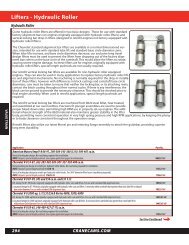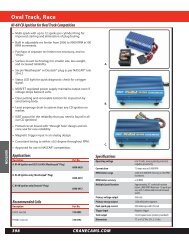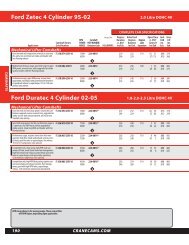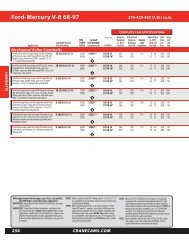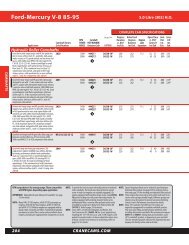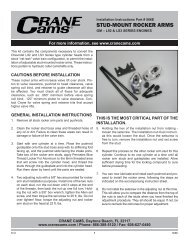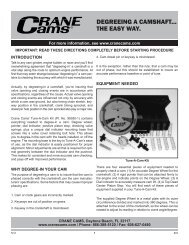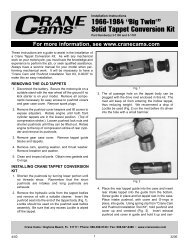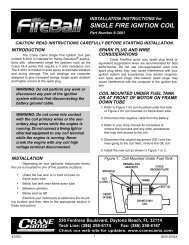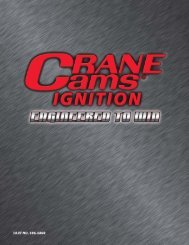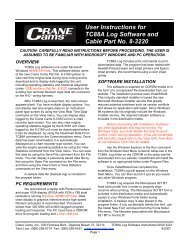2011 - Crane Cams
2011 - Crane Cams
2011 - Crane Cams
Create successful ePaper yourself
Turn your PDF publications into a flip-book with our unique Google optimized e-Paper software.
Degreeing the Cam<br />
Degreeing the Cam<br />
What is Meant by Degreeing the <strong>Cams</strong>haft, and Why is<br />
it Necessary?<br />
The term “Degreeing In Your <strong>Cams</strong>haft” means you are<br />
making sure the camshaft’s position in the engine coincides<br />
with that of the crankshaft, so that their rotation is<br />
synchronized. This is the only way you will know if the<br />
rise and fall of the pistons properly matches the opening<br />
and closing of the valves, so the engine will run<br />
properly. A few degrees of misalignment can affect the<br />
engine’s operation dramatically. If the circumstances<br />
were perfect, one would only need to line up the marks<br />
on the timing chain sprockets and the cam would be<br />
degreed. In reality, you are dealing with a group of<br />
components (the camshaft, crankshaft, timing chain,<br />
and sprockets), all with their own standards and tolerances.<br />
If these tolerances stack up against you, it could<br />
throw you out of alignment. Without degreeing the<br />
cam you can never be sure that the parts are in correct<br />
position. If you have the tools and expertise, we always<br />
recommend that the camshaft’s position in the engine<br />
be degreed in.<br />
Is There More Than One Way to Degree a Cam, and<br />
Which is Better?<br />
Currently there are two popular methods for degreeing<br />
a cam: the centerline method, and the duration at<br />
.050” lift method. We believe it is far better to degree<br />
the camshaft with either method than not to degree<br />
the cam at all; but of the two methods, the duration at<br />
.050” lift is much more accurate.<br />
The main problem with the centerline method is it has<br />
you finding the theoretical centerline of the intake and/<br />
or exhaust lobe and line up on it. It makes the basic<br />
assumption that the lobe you are checking is symmetrical,<br />
with its opening side being the exact same shape<br />
and size as the closing side of the lobe. The truth is that<br />
most modern lobes are asymmetrical, with the opening<br />
side of the lobe being much more aggressive and the<br />
closing side being more gentle. Therefore, when you<br />
attempt to locate the middle (or centerline) of the<br />
asymmetrical lobe there is an automatic error factor. It<br />
could be as little as 2° off or as much as 6°, depending<br />
on the exact lobe shape and the procedure used during<br />
the degreeing operation. Neither does it verify that<br />
the camshaft has been properly ground with the correct<br />
duration lobes, which can drastically affect performance.<br />
Since the duration at .050” lift method is not affected by<br />
the asymmetrical lobe design, we believe it is the more<br />
accurate way to degree.<br />
What Tools Will I Need to Degree the Cam?<br />
The basic tools required are:<br />
1. A degree wheel, such as <strong>Crane</strong> <strong>Cams</strong> part no. 99162-<br />
1. You can also use a professional fully degreed<br />
damper or hub, or install degree tape to your stock<br />
damper. Be sure to get the tape that matches the<br />
diameter of the damper. Use whatever will give you<br />
accurate markings for 360°.<br />
2. A stable pointer that can be conveniently mounted to<br />
the engine.<br />
3. A dial indicator with at least a half inch of travel in<br />
.001” increments. A rigid stand that mounts to the<br />
engine or with a magnetic base to hold the dial indicator<br />
will also be required.<br />
4. A positive stop device to locate T.D.C. such as <strong>Crane</strong><br />
<strong>Cams</strong> part no. 99410-1 or 99412-1 will be necessary.<br />
(You can make your own by using an old spark plug.<br />
Remove the porcelain insides, then drill and tap the<br />
interior of the spark plug housing and thread a long<br />
bolt through it.)<br />
All of the above tools are in the <strong>Crane</strong> <strong>Cams</strong> Tune-A-<br />
Cam Kit, part no. 99030-1.<br />
Tune-A-Cam Kit<br />
Critical cam and valve train checking chores can be made<br />
easier, more accurate and faster when you have the correct<br />
tools handy. <strong>Crane</strong> <strong>Cams</strong>’ Tune-A-Cam Kit, Part No.<br />
99030-1, contains all the items required to degree-in<br />
your camshaft, check valve-to-piston clearance, etc.<br />
These items are all enclosed in their own foam protected,<br />
hard plastic carrying case.<br />
Section Continued<br />
866-388-5120 • 386-236-9983 FAX 381



